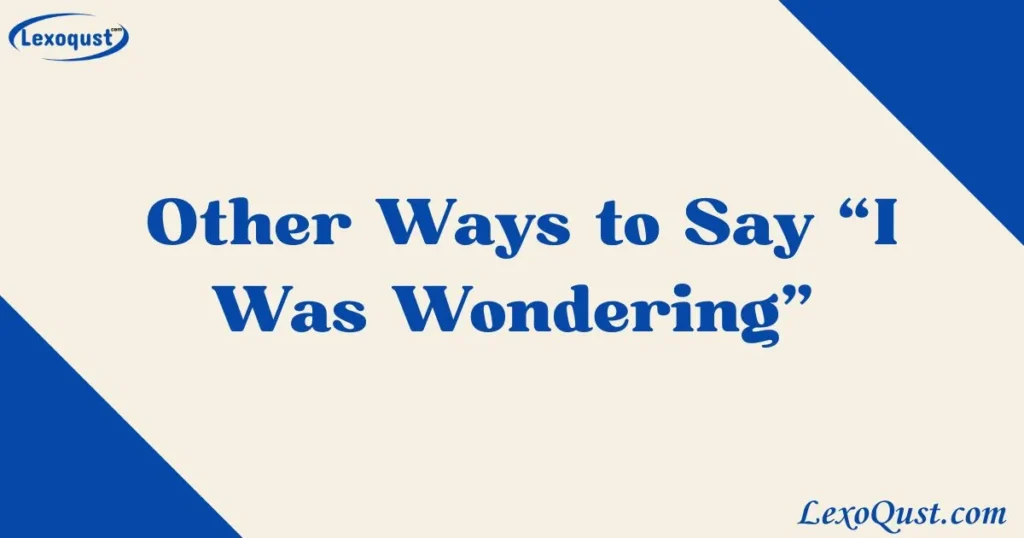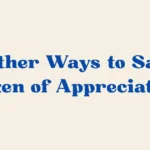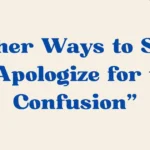Other Ways to Say “I Was Wondering” play a powerful role in shaping how your message is received when it comes to effective communication in formal writing.
Whether you’re drafting a business email, writing a research report, or crafting a heartfelt letter, the right phrasing can add clarity, warmth, and professionalism. One commonly overused phrase — “I was wondering” — while polite, can sometimes feel vague or overly passive.
In this guide, we’ll explore 33 polite alternatives to “I was wondering” to help you elevate your tone and connect more meaningfully. These professional ways to express curiosity will support your goal of writing with intention, respect, and refined clarity.
What Does “I Was Wondering” Mean?
“I was wondering” is a polite and indirect way to introduce a question or request, often used to soften the tone. It expresses curiosity or a desire for information without sounding too forward, making it common in both casual and formal writing.
When to Use “I Was Wondering”
Use “I was wondering” in emails, conversations, or reports when you want to ask for something respectfully like a clarification, favor, or decision without putting pressure on the recipient. It’s particularly useful when tone and tact are important.
Is It Professional/Polite to Say “I Was Wondering”?
Yes, it’s considered polite and moderately professional, but it can sound vague or overly tentative if overused. For sharper communication, try refined phrases for professional questions or other polite inquiry alternatives to match the tone of your message and maintain credibility.
1. May I Ask for Your Input
Meaning: Expresses a polite interest in hearing the other person’s thoughts.
Definition: A courteous phrase used to invite someone’s opinion or feedback.
Tone: Respectful and engaging.
Example: May I ask for your input on the draft proposal before I submit it?
Explanation: This phrase encourages collaboration and shows openness to others’ perspectives.
Purpose and Personalization: Use this to invite contribution respectfully; you can personalize it by adding the topic or context, like “your input on the marketing plan.”
2. Do You Happen to Know
Meaning: Softly introduces a question to avoid sounding demanding.
Definition: An indirect and gentle way to seek information.
Tone: Casual and considerate.
Example: Do you happen to know when the next update is scheduled?
Explanation: It’s effective in informal or semi-formal contexts where friendliness matters.
Purpose and Personalization: Ideal for lowering pressure; adjust by replacing “happen to” with a firmer tone if needed, e.g., “Could you confirm…”
3. Could You Help Me Understand
Meaning: Seeks clarification or explanation with humility.
Definition: A polite expression used to request clearer insight or guidance.
Tone: Humble and respectful.
Example: Could you help me understand the reasoning behind this decision?
Explanation: It shows a willingness to learn rather than challenge, encouraging open communication.
Purpose and Personalization: Use this in both professional and academic writing; personalize by noting specific areas where clarity is needed.
4. I’m Reaching Out to Learn
Meaning: Indicates a proactive effort to gain knowledge or clarity.
Definition: A professional opening line to express curiosity or intent to inquire.
Tone: Direct yet polite.
Example: I’m reaching out to learn more about your hiring process.
Explanation: It balances professionalism with initiative, ideal for formal emails.
Purpose and Personalization: Best for outreach messages—personalize by referencing specific interests or goals.
5. I’d Be Grateful to Know
Meaning: Conveys appreciation while making a polite inquiry.
Definition: A courteous phrase to request information or input.
Tone: Gracious and formal.
Example: I’d be grateful to know if there are any deadlines I should be aware of.
Explanation: This softens the request and builds goodwill through gratitude.
Purpose and Personalization: Great for professional requests—add warmth by tailoring to your audience’s role or expertise.
6. I Would Like to Know
Meaning: Directly expresses interest in obtaining information.
Definition: A formal and respectful way to ask a question.
Tone: Polite and inquisitive.
Example: I would like to know your thoughts on this proposal.
Explanation: It’s straightforward yet courteous, suitable for both business and academic contexts.
Purpose and Personalization: Use when clarity is key; personalize with a specific subject or action.
7. Could You Please Clarify
Meaning: Requests a clearer explanation or definition.
Definition: A tactful way to seek understanding.
Tone: Professional and sincere.
Example: Could you please clarify what you meant by the revised timeline?
Explanation: Avoids misunderstandings by inviting elaboration.
Purpose and Personalization: Excellent for formal writing—tailor based on the confusion point or communication style.
8. I’m Curious About
Meaning: Shows interest in learning more about a topic.
Definition: A gentle and open way to introduce a question.
Tone: Friendly and informal.
Example: I’m curious about the team’s approach to innovation.
Explanation: Encourages open dialogue and exploration.
Purpose and Personalization: Great for relaxed settings—adjust the tone for business by adding context.
9. I Was Hoping to Understand
Meaning: Expresses a desire to gain insight in a considerate manner.
Definition: A soft, polite way to request clarification.
Tone: Thoughtful and respectful.
Example: I was hoping to understand your expectations for this project.
Explanation: Reduces pressure while showing sincere interest.
Purpose and Personalization: Use in discussions with supervisors or mentors; personalize with project details.
10. I Would Appreciate Your Thoughts On
Meaning: Invites feedback or opinions with gratitude.
Definition: A respectful request for input.
Tone: Appreciative and collaborative.
Example: I would appreciate your thoughts on the new design draft.
Explanation: Highlights that the other person’s view is valued.
Purpose and Personalization: Use in peer reviews or team settings—add specifics to focus responses.
11. Would It Be Possible To Know
Meaning: Softens a question to sound less intrusive.
Definition: A formal phrase for requesting information.
Tone: Respectful and tactful.
Example: Would it be possible to know the results by Friday?
Explanation: Adds professionalism while preserving a courteous tone.
Purpose and Personalization: Perfect for client or manager communication—adjust based on urgency or hierarchy.
12. I’m Interested in
Meaning: Indicates genuine curiosity or professional interest.
Definition: A concise way to express desire for more knowledge.
Tone: Engaged and positive.
Example: I’m interested in how your department manages remote workflows.
Explanation: Keeps tone open and non-demanding.
Purpose and Personalization: Use in networking or research writing—make it specific to your audience’s expertise.
Learn more Sweet Ways to Say “I Miss You”
13. Could You Provide More Details
Meaning: Requests further explanation to gain clarity.
Definition: A direct and courteous ask for elaboration.
Tone: Professional and neutral.
Example: Could you provide more details on the implementation plan?
Explanation: Encourages completeness and precision.
Purpose and Personalization: Use in reports or follow-ups—tailor based on what’s missing or unclear.
14. I Would Like to Inquire About
Meaning: A formal way of initiating a question.
Definition: Used to begin a professional or structured query.
Tone: Formal and respectful.
Example: I would like to inquire about your return policy.
Explanation: Keeps tone professional and objective.
Purpose and Personalization: Ideal for formal letters—adjust formality level based on audience.
15. I Am Seeking Information On
Meaning: Expresses an active effort to gather data.
Definition: A structured way to request knowledge.
Tone: Formal and goal-focused.
Example: I am seeking information on industry best practices.
Explanation: Clearly states intent and purpose.
Purpose and Personalization: Use in professional research—specify topics to make the request efficient.
16. Would You Be Able to Provide Insight On
Meaning: Requests thoughtful input or expertise.
Definition: A professional phrase for asking an opinion or analysis.
Tone: Respectful and curious.
Example: Would you be able to provide insight on client behavior trends?
Explanation: Invites detailed and informed responses.
Purpose and Personalization: Ideal for expert interviews—mention specific issues or angles.
17. I Was Wondering if You Could
Meaning: A polite and indirect way of making a request.
Definition: Softens the tone of a question to avoid pressure.
Tone: Friendly and cautious.
Example: I was wondering if you could review this document today.
Explanation: Makes requests sound less demanding.
Purpose and Personalization: Use when tone matters—personalize based on urgency or relationship.
18. I Would Like to Request
Meaning: Clearly states a need or desire.
Definition: A formal and direct phrase for making requests.
Tone: Respectful and professional.
Example: I would like to request an extension for the deadline.
Explanation: Ensures clarity without being abrupt.
Purpose and Personalization: Best for official emails—adjust based on authority level and tone.
19. Could You Kindly Advise
Meaning: Requests guidance in a polite manner.
Definition: A formal ask for recommendations or instructions.
Tone: Courteous and deferential.
Example: Could you kindly advise on next steps for onboarding?
Explanation: Adds grace to requests, especially in formal contexts.
Purpose and Personalization: Use in client or executive communication—tailor based on topic or relationship.
20. Might I Ask
Meaning: A very polite and tentative way of posing a question.
Definition: A soft introduction to a query.
Tone: Polished and courteous.
Example: Might I ask how you arrived at that conclusion?
Explanation: Signals respect and openness.
Purpose and Personalization: Great for sensitive questions—personalize by adding context or gratitude.
21. Would It Be Possible to Find Out
Meaning: Politely expresses a desire to obtain specific information.
Definition: A respectful phrase to make a careful inquiry.
Tone: Formal and considerate.
Example: Would it be possible to find out when the budget review will be finalized?
Explanation: Keeps communication professional while inviting a response.
Purpose and Personalization: Suitable for business emails or formal reports—personalize with relevant timelines or topics.
22. I Was Thinking About
Meaning: Gently introduces an idea or potential question.
Definition: A casual yet thoughtful phrase for sharing thoughts.
Tone: Reflective and informal.
Example: I was thinking about ways we could improve our outreach strategy.
Explanation: Encourages collaborative thinking without pressure.
Purpose and Personalization: Great for team conversations—adapt tone for formal settings by focusing on strategic outcomes.
23. I Would Be Interested in Knowing
Meaning: Expresses personal or professional curiosity.
Definition: A polite way of requesting information.
Tone: Inquisitive and respectful.
Example: I would be interested in knowing how the feedback process works.
Explanation: Shows initiative and a willingness to learn.
Purpose and Personalization: Use when following up on meetings or policies—personalize with clear intent.
24. Could You Share More Information
Meaning: Requests additional clarity or details.
Definition: A direct yet courteous phrase for gaining more context.
Tone: Professional and neutral.
Example: Could you share more information about the partnership proposal?
Explanation: Helps avoid ambiguity and improves collaboration.
Purpose and Personalization: Great for clarifying plans—tailor based on what specific info is needed.
Dive deeper Other ways to say safe travels
25. I Was Hoping You Could
Meaning: Politely introduces a hopeful request.
Definition: A tactful phrase for making a gentle ask.
Tone: Warm and humble.
Example: I was hoping you could send the finalized report by tomorrow.
Explanation: Keeps tone soft and friendly, reducing tension.
Purpose and Personalization: Best when addressing superiors or busy professionals—personalize urgency or tone to the situation.
26. I Would Like to Explore
Meaning: Indicates a desire to examine or investigate something further.
Definition: A professional way to express intent to delve deeper into a topic.
Tone: Curious and open-minded.
Example: I would like to explore new collaboration opportunities with your team.
Explanation: Signals strategic interest and initiative.
Purpose and Personalization: Useful in proposals or brainstorming—mention specific areas of interest for stronger impact.
27. I Am Keen to Understand
Meaning: Emphasizes strong interest in gaining clarity.
Definition: A formal expression of curiosity and willingness to learn.
Tone: Respectful and enthusiastic.
Example: I am keen to understand how this approach aligns with our objectives.
Explanation: Enhances communication by showing eagerness without pressure.
Purpose and Personalization: Ideal for high-level discussions—personalize based on project or team context.
28. Could You Please Share
Meaning: Courteously requests access to details or updates.
Definition: A straightforward and professional phrase for asking information.
Tone: Polite and formal.
Example: Could you please share the client feedback from last week?
Explanation: Encourages cooperation without sounding demanding.
Purpose and Personalization: Works well in professional settings—add context to make the ask more focused.
29. I Would Like to Discuss
Meaning: Introduces a topic of conversation or concern.
Definition: A direct yet respectful phrase to open dialogue.
Tone: Collaborative and purposeful.
Example: I would like to discuss our upcoming budget changes.
Explanation: Facilitates open, solution-oriented conversations.
Purpose and Personalization: Ideal for meetings or planning—personalize by specifying the scope or issue.
30. Would You Mind Elaborating
Meaning: Politely asks for more in-depth explanation.
Definition: A soft, respectful way to encourage further detail.
Tone: Thoughtful and tactful.
Example: Would you mind elaborating on your concerns about the timeline?
Explanation: Makes the recipient feel heard and respected.
Purpose and Personalization: Use in collaborative environments—personalize by referencing the exact topic needing elaboration.
31. I Was Hoping for Some Clarification
Meaning: Expresses a gentle need for more understanding.
Definition: A tactful request for additional explanation.
Tone: Humble and sincere.
Example: I was hoping for some clarification on the project’s scope.
Explanation: Helps resolve confusion while maintaining a respectful tone.
Purpose and Personalization: Ideal for team interactions—personalize based on the area of uncertainty.
Explore more Other Ways to Say “Sincerely”
32. Would It Be Possible to Clarify
Meaning: A formal request for more precision or clarity.
Definition: A polite way to ask for a better explanation.
Tone: Diplomatic and respectful.
Example: Would it be possible to clarify the client’s main priorities?
Explanation: Keeps the tone professional and focused on understanding.
Purpose and Personalization: Best for emails or meetings—personalize with a clear focus area.
33. Could I Have More Information On
Meaning: Requests further details on a specific subject.
Definition: A professional way to seek additional insights.
Tone: Neutral and businesslike.
Example: Could I have more information on the deliverables timeline?
Explanation: Promotes thorough understanding and preparation.
Purpose and Personalization: Effective in planning or project phases—adjust wording to match the level of detail needed.
34. Would You Be Willing to Explain
Meaning: Gently seeks someone’s willingness to provide information.
Definition: A soft, respectful ask for clarity or reasoning.
Tone: Considerate and humble.
Example: Would you be willing to explain your approach to the presentation?
Explanation: Opens the door for a thoughtful, collaborative exchange.
Purpose and Personalization: Ideal in mentoring or team settings—personalize by acknowledging their expertise.
35. I Am Curious to Learn
Meaning: Shows genuine interest in gaining knowledge or insight.
Definition: A simple yet thoughtful expression of curiosity.
Tone: Warm and inquisitive.
Example: I am curious to learn more about how your team handles remote collaboration.
Explanation: Invites dialogue in a way that feels authentic and open.
Purpose and Personalization: Perfect for interviews or professional growth conversations—customize based on subject matter or role.
Conclusion
Choosing the right words like finding professional ways to say “I was wondering” can transform your message from vague to impactful. Thoughtful phrasing builds trust, clarity, and connection, whether you’re writing an academic paper, business email, or personal letter. I hope this guide becomes a practical resource for your journey toward warm and thoughtful communication.
Try weaving these alternatives into your writing for more confidence and professionalism. Every phrase you choose shapes how you’re understood—so why not make it count? Thank you for reading, and may this post support you in expressing yourself with authenticity and purpose.

Hi! I’m Amelia Ashford, the admin of Lexoqust.com. Here, we dive deep into the world of synonyms to help you express yourself better.From everyday words to advanced vocabulary, Lexoqust makes your writing richer and more refined.



